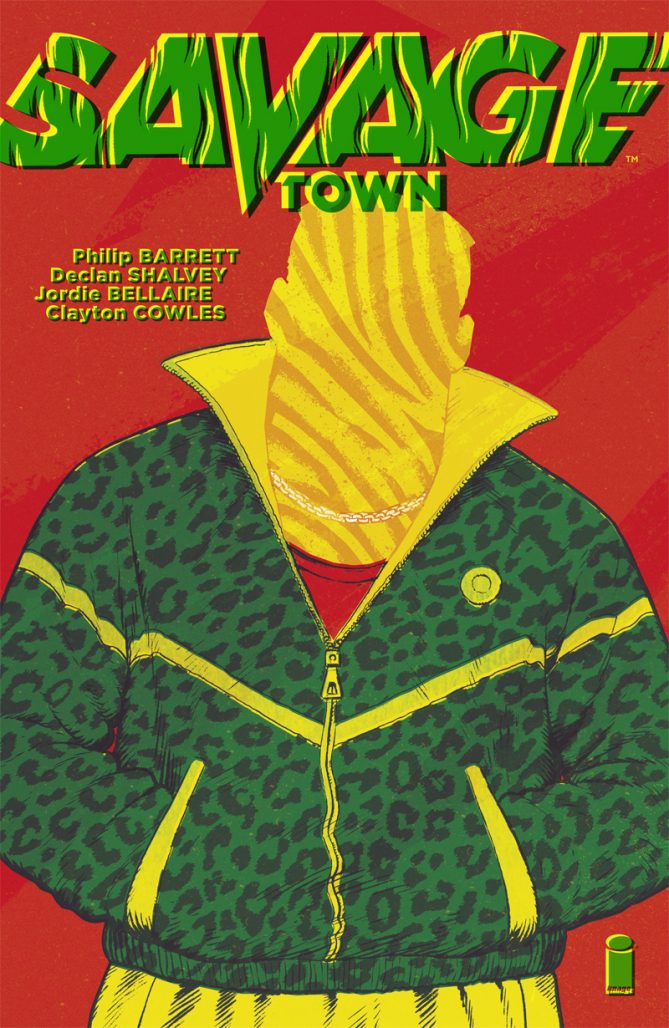
Recently, the Beat had a chance to sit down with Savage Town writer Declan Shalvey. Best known for his artistic work with Warren Ellis on Moon Knight and Injection, Shalvey is outspoken about helping comics illustrators get the credit they deserve from critics and fans. In this first part of a two part interview, Shalvey discusses why it was so important for him to work with Irish cartoonist Philip Barrett, who is relatively unknown in the US but is described by Shalvey as the best storyteller in Ireland, on this book. Shalvey also goes into detail about how he and the rest of the creative team built up this fictionalized Limerick into a living, breathing city that sucks you in at first sight.
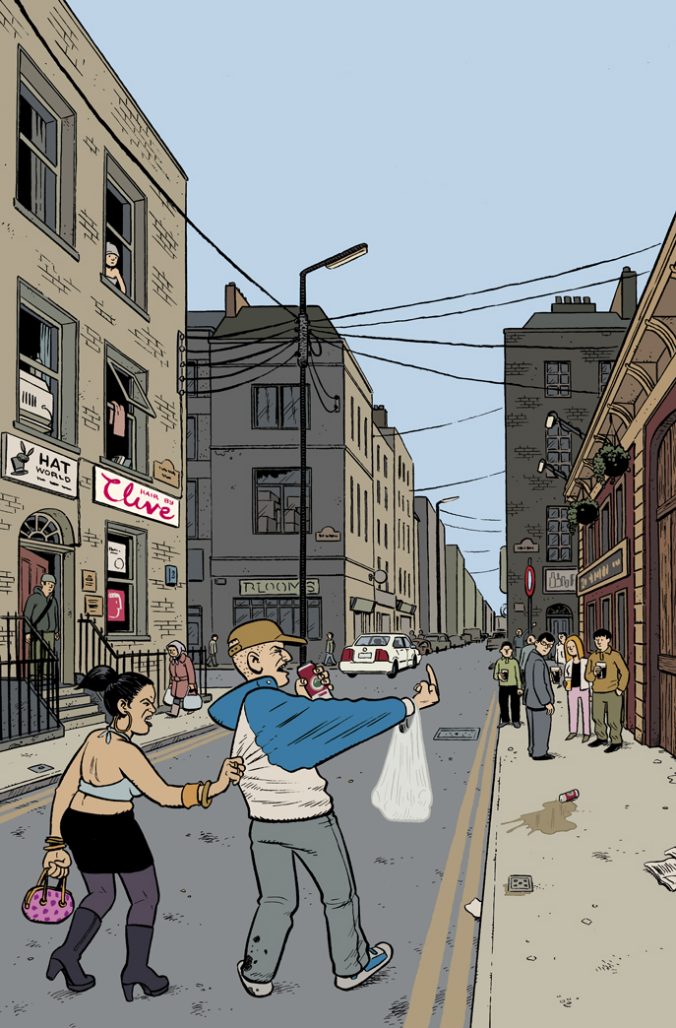
Shalvey: Well, I never actually wrote Savage Town as a series. I pitched it as a series, so I had my first ten pages or so done. Then when we said we’d do it as an OGN, I thought “okay, the first pages are done. I’m moving on. Great!” But I had a very specific structure for the book in mind that works well from month to month and that went out the window once I realized this would be one contained story.
Writing the book as an OGN meant that I wouldn’t have to have a climax at the end of every chapter, but I found that I tended to have a climax at the end of every chapter anyways. I found that the real benefit of writing an OGN was that I didn’t need to start the next chapter explaining what happened at the end of the last one. That meant I could squeeze more story in. I could use the extra space for pacing rather than reminding people where we were and what the location is and whatnot.
To be honest though, a lot of writing Savage Town was learning as I went. When I was about one chapter into writing it, I was asked to write and draw a [Nick] Fury story for Marvel. It was a serial as part of a Civil War II: Choosing Sides anthology that they were doing. And in it, they were basically looking for six short stories. There would be something different happening in each one, but I tried to construct it in a way where you could read it as one whole story or a bunch of shorter, separate ones. It was a really good exercise in keeping things episodic but telling an ongoing story, which was exactly what I was doing in Savage Town on a larger scale.
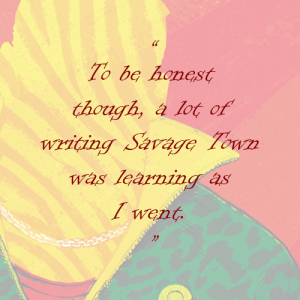
Lu: Having established yourself for so long as an artist, was there anything in particular that surprised you about transitioning over to writing?
Shalvey: The best bit about drawing comics, for me, is doing the layouts. It’s where everything kicks in and the composition works. It’s where you work out the pacing of a written script and make it work as visuals. It’s like solving a puzzle. That, to me, is making comics. Sometimes, having to work on actual pages is annoying because you’ve already solved all the storytelling problems and it’s just a slog to get to the inking.
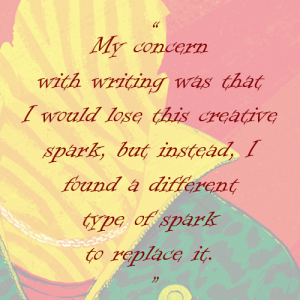
My concern with writing was that I would lose this creative spark, but instead, I found a different type of spark to replace it.
Lu: Where does Phil fall into this process of script writing and storytelling?
Shalvey: Because I was so busy, I never got the chance to write ahead on Savage Town. Typically, I like to have a script in the bag before I work on something and I can tell Phil likes that too, so I think I let him down in that regard. I think he would have liked to have, for example, chapter two of Savage Town when he was working on chapter one. I always made sure Phil had a script when he needed it, but I didn’t live up to my own standards beyond that, basically.
But as a result, what happened was that when Phil finished chapter one and I’d have chapter two ready for him, I could see all the art from the first chapter as I started working on the third. That inspired things. In one part of the first chapter, I saw that Phil had drawn one character with a really interesting face, so I said “oh, that guy is really cool! I’ve got to get him in again somewhere.” So, that’s weird. It’s like you’re making a film and someone is casting it and as they’re casting, you’re getting new ideas for story. So much of writing Savage Town ended up being a response to what Phil was drawing. I’d want to see more of something or have another scene where some of the characters he’d drawn could come into the story more.
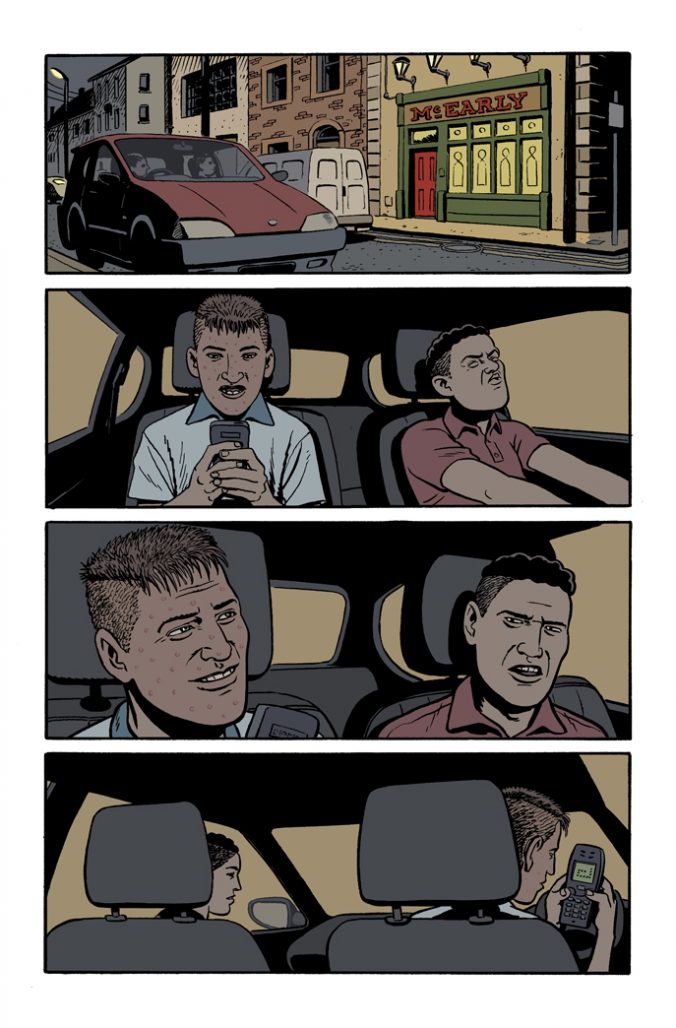
If I had sat down and wrote the book in one go, that is the kind of magic that wouldn’t have happened.
Lu: What made you decide that Phil was the right artist for Savage Town?
Shalvey: Phil is an amazing artist and he’s been drawing comics longer than I have. It drove me crazy wondering why everybody doesn’t already know who this fucking guy is. I wanted to read a Phil Barrett book. I wanted to read a proper book that was drawn by him.
Before I started Savage Town, I knew I couldn’t draw it because that would mean that I’d have to stop drawing Injection. So I thought, instead of putting all my eggs in one basket, why don’t I take everything I’ve built up and try and give someone else a leg up with [Savage Town] the way Warren [Ellis] gave me one. Just working with Warren changed how everybody saw my work and hugely empowered me, so I wanted to do that for somebody else. And I wanted it to be an Irish person because I wanted the artist of Savage Town to be somebody that really knew the location.
So at that point I thought to myself, “well, I’m doing well with Image and I have this relationship with them, so I wonder if making a book with Phil would be something I could do.”
I could never see Phil working at Marvel or DC. I love his style but it’s not “mainstream” comics. But I thought that if I was going to do a book that’s a little bit different already, I should just lean in and work with an artist that makes it even more different. Especially because I was working at Image Comics. You can do stuff that looks more mainstream but I feel like the stuff that feels more authentic there are the things that are more unique.
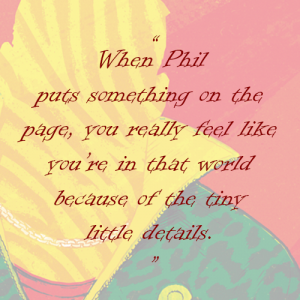
At one point when Jordie was coloring the book, she working on a housing estate and she said “oh, this looks just like where your mum lives.” I thought “that’s perfect!” If I had sent that script page to, say, a Brazilian artist, they wouldn’t understand. It’s not that they wouldn’t be able to draw it, but there’s a certain aesthetic to the country that I wanted to capture to make the book feel authentic and not just look like a drawing. And I think Phil has even more of that aesthetic than I do. When Phil puts something on the page, you really feel like you’re in that world because of the tiny little details. It’s the cups in the kitchen and the shape of the kettle and the toaster. It’s the shoddy wallpaper and the terrible gaudy tracksuits. His attention to detail is amazing.
Lu: When you first saw Phil’s work, what was it about his style that made it stand out to you?
Shalvey: Well, he’s an exceptional cartoonist. His drawing in Savage Town is a little more realistic than some of the stuff he does in his own time, but he’s a seminal cartoonist and a fantastic storyteller. A lot of the time, I’ll see kids with portfolios which are all based on the exact stuff I grew up on—90s adrenaline. Phil’s stuff, though, is completely void of that. It’s all about story, character, and pacing. Some of his own work is very slice of life– you know, just people going out for a pint or going through a breakup, but all of that looks and feels real. I’ve always really responded to that stuff coming from him.
I just don’t think there’s a better storyteller or cartoonist in the country. I say that as someone who is very impressed with the standard of stuff coming out of Ireland right now. I think there’s like, five artists from Ireland working at Marvel right now in some capacity be it colors or whatnot. There’s a really great standard of stuff coming from this country but what Phil does is just so different from what all those other people, including myself, do.
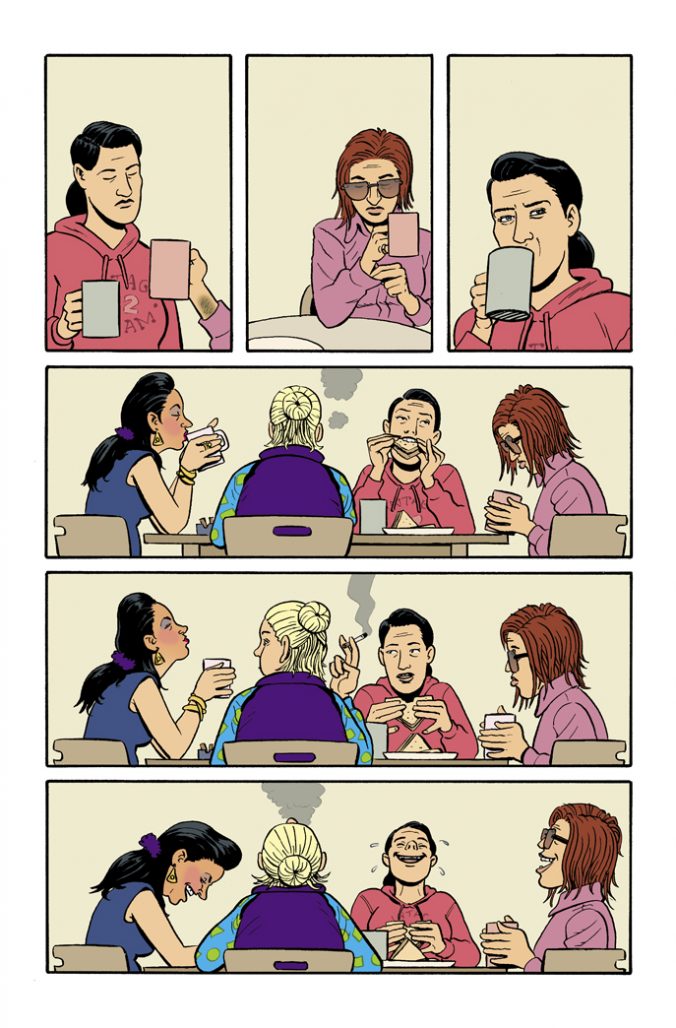
Shalvey: Yeah, it really bugs me when I see artists with a good eye for stuff because I think “goddamn it!” I’m not as observant. I have to put effort into that stuff. I mean, I’m sure they do too, but they make it look so easy. And as someone who works behind the scenes, I should know better because I’m sure they do put in a lot of work, but when you just see the finished drawings you’re like “fuck you, man!”
So much of the style work Phil does is so smart. In the pub scene, you can see all these old, old jars. I remember being a kid and going to people’s houses and seeing all these little knickknacks lying around. But even though I’m from Ireland and know this place, I don’t know if I would’ve thought to include that if I were drawing the book.
Lu: I think that the things artists emphasize when they draw sort of show you where their focuses lie in real life.
Shalvey: Yeah, I think so too. I wonder what Phil would do doing a crazy science fiction story because I don’t think he’d do something like that and not give it the same time and sensibilities. I’m quite different, though. I think I’m a more economical storyteller. I work things out in layouts and make sure to tell a story but don’t always give myself time to inform the world with things like backgrounds and stuff. I have a very hard time seeing a room as something other than a box if you know what I mean and it takes me a lot more time to fill that box with information that says more about the characters. I’m a very functional storyteller in that way.
Lu: You have a very good eye for kinetic movement. Your action sequences in things like Moon Knight and the All-Star Batman backups are very dynamic.
Shalvey: I definitely like to lead the eye around the page through composition and whatnot. I feel like one of my strongpoints is that I know where to put the work in. For example, in Injection, there might be a scene where I don’t have a background, but the next page will have a really intricate background that lets you know exactly where things are. If something feels unnecessary to me in a story though, I have no problem cutting it, whereas I have some friends that are way better at drawing than I am, but aren’t able to just cut things from scenes. They’re too into the technical craft of making the art. I think my strength is that I know I can work a little faster because I know I can choose my battles, basically. I know where to allocate my time budget.
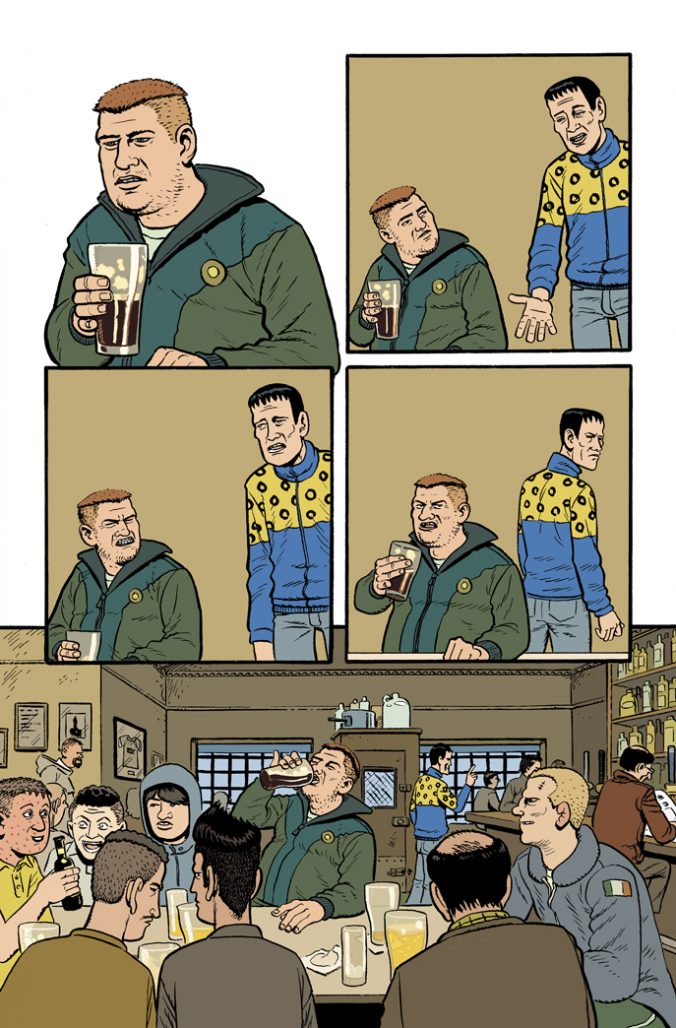
Shalvey: The weird leopard prints on the blue, right? No, I think it’s just rotten. A really awful jacket. The jacket does remind me of an interesting story, though. At the beginning of the process, Jordie was talking about giving Savage Town a very different color approach where everything looked slightly more monochrome. However, Phil had a really good point about how everything in that city is already so drab that the colorful, gaudy tracksuits really pop. And we really embrace that gaudiness on the cover, going full blast ignorant with the colors. The awful patterns and the terrible fashion sense. And the weird thing is that it still looks kind of contemporary because people from Limerick still dress the same way.
Lu: Jumping off from that, and this may be more of a question for Jordie, but a lot of the colors in Savage Town are relatively pale with the exception of yellow. Yellow is omnipresent in all these small ways throughout the book and when it’s there, it hits you very hard. Why all the yellow?
Shalvey: That’s interesting. I must bring that up to her. There’s even a page she handed in the other day that features a drab scene outside a chipper and she just has this lovely yellow light inside that really pops out. I guess it must. If something’s more of a generally drab area, those colors are going to pop more. I mean, Jordie lives in Ireland with me for the last six years so she knows… she hasn’t been to Limerick much, but she knows what drab days look like and what all those old buildings and estates look like because she’s seen them over the years.
I could have had an Irish colorist do this book and part of me would have liked to have done that. There are Irish colorists that are actually doing really well right now, I have to say, which is great. But frankly, Jordie is a two time Eisner-winning colorist, so I’m going to use her if she’ll make herself available. There’s just nobody who’s going to make those smarter choices, you know?
Phil’s work could end up looking like a coloring book because everything’s very open and self-contained. If you printed one of Phil’s pages, a kid would have a field day just coloring the faces and the tracksuits. And Jordie has spent a good while on his pages, too. I thought she’d color this book in fucking no time, because I’ve seen the work she puts into say Gabriel Hernandez Walta’s or Greg Smallwood’s pages. But instead, I’d say she’s spending more time on Phil’s pages than she spends on my pages, for fuck’s sake.
But I know why she’s doing that—she’s making sure every little object is consistent. Phil goes in and draws every little nook and cranny; every lace on the shoe and every watch, so Jordie’s getting real into coloring it all. It’s tough to praise her because there’s so much smart stuff that she does that nobody would ever notice. Thankfully there are things… it’s very interesting what you said about the yellow…I want to look it over again, now, and keep that in mind.
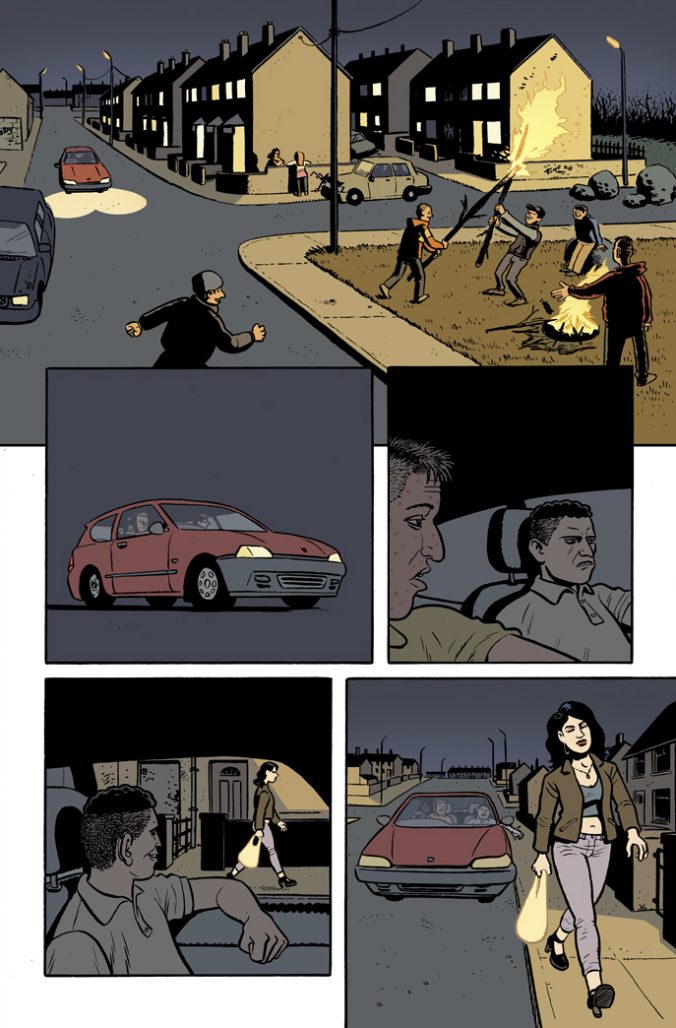
Shalvey: I really built that page for Phil. It’s basically 7 o’clock. It’s that midnight hour before your parents call you in for dinner. It’s the thing I remember really well about being a kid…when you’d be allowed to play outside. It’s getting dark and it’s a little too dark– you shouldn’t still be out but you’re chancing your arm before your parents call you inside. I described that to Phil and he did it perfectly. But when Jordie colored it, I mean, she’s not from Ireland. She wouldn’t have got it, and yet, when I saw it I just remembered being a kid again. It just was fantastic. I love it.
I want Savage Town to be a book that you can pick up whether you’re American or Irish. It was very much my aim to try and make something that hits two different types of audiences. So, an audience that doesn’t know comics in Ireland can get behind the comic and an audience in America that wouldn’t necessarily know what an Irish comic is can get behind that. I guess we’ll see what happens.
Lu: I definitely think Savage Town captures the general feeling of being in Ireland. The book being an OGN helps a lot in that regard because you get to sit with the world for a much longer period than you would if you only got to stay in it for 22 pages a month.
Shalvey: That’s a good point and something I was aware of. Sometimes I pick up some stuff that has imaginary slang words or something like that and if you only get to read 20 pages of that kind of thing, you’re like, “oh, fuck this.” But because Savage Town is a graphic novel, I have an advantage. Once you buy the book, you’re going to read it through. I might not have you at 20 pages, but when you get to 30 pages, I feel like you’ll be in.
That’s why I like it when the English guy turns up later on in the book. He speaks so differently from everyone else in the cast that by the time he shows up, his speech is kind of jarring to you as a reader. My hope is that you’re so into the book at that point that you have to be reminded that people outside of Ireland don’t talk like Irish people do.
Lu: I love how Clayton [Cowles] lettered him.
Shalvey: I think it was Sebastian’s idea and when he suggested it, I laughed for five minutes straight. I just thought it was great. I’m glad you picked up on it. I needed those words to be fancy. You can hear the English accent when you read it. This is another example of me having the freedom [to make] the book whatever I wanted it to be…it really had to be the best book I could possibly make. I don’t know if it’s good anymore– I’m too close to it– but it’s definitely what I wanted it to be. For better or worse. So if somebody doesn’t like the dialogue or whatever…those were all my decisions, I’m happy with the decisions I made.
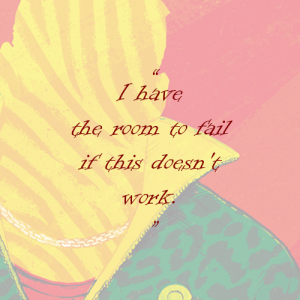
Lu: You make it sound like that’s nothing.
Shalvey: Just in that I’m very fortunate. For a “risky” project,” there really is no downside. Worst case scenario, some people buy the book. They get exposed to Phil and the enjoy it. That’ll just be great. I’d love it if the book did brilliant because I’d love to do more– I have a couple of books in mind to do afterwards– but it really wasn’t that difficult a thing to do because I’m secure, Jordie’s secure, Clayton’s secure– Phil’s unknown, so hopefully this could bring more spotlight to Phil– and in the meantime Jordie’s still coloring Spider-Man and I’m still doing Injection and what not.
If you liked it, that’s a great sign because you’re not Irish. The most important thing is really [what people] from Ireland are going to think of it, but any friend of mine who I’ve sent it to has seemed to really, really, really enjoy it.
Look out for the second part of this interview tomorrow, when we take an in-depth, spoiler-filled look at the themes and ideas behind Savage Town. We also discuss the story’s historical inspirations and the controversy the book’s release has caused in Ireland.


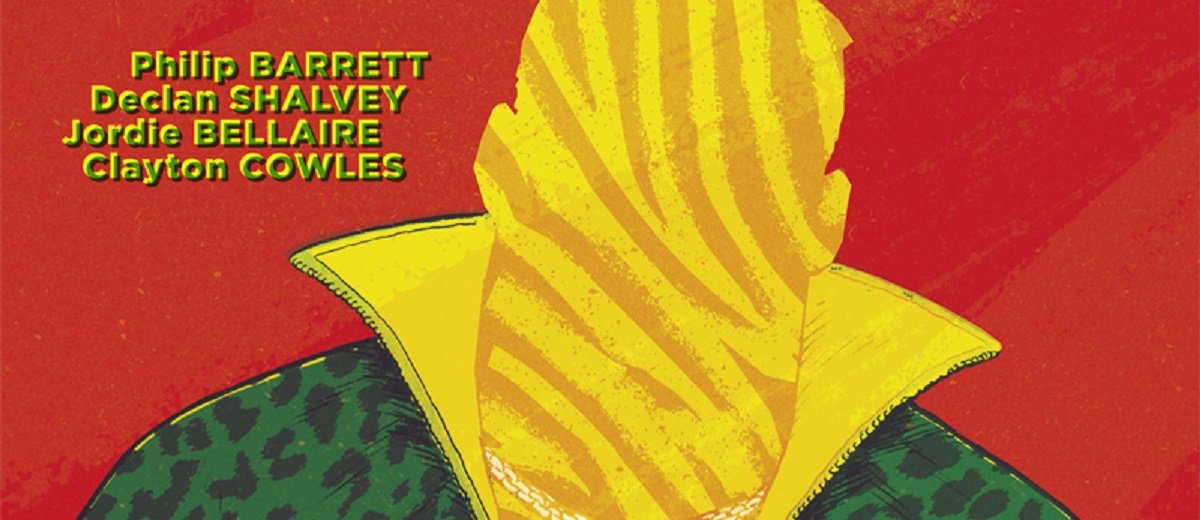
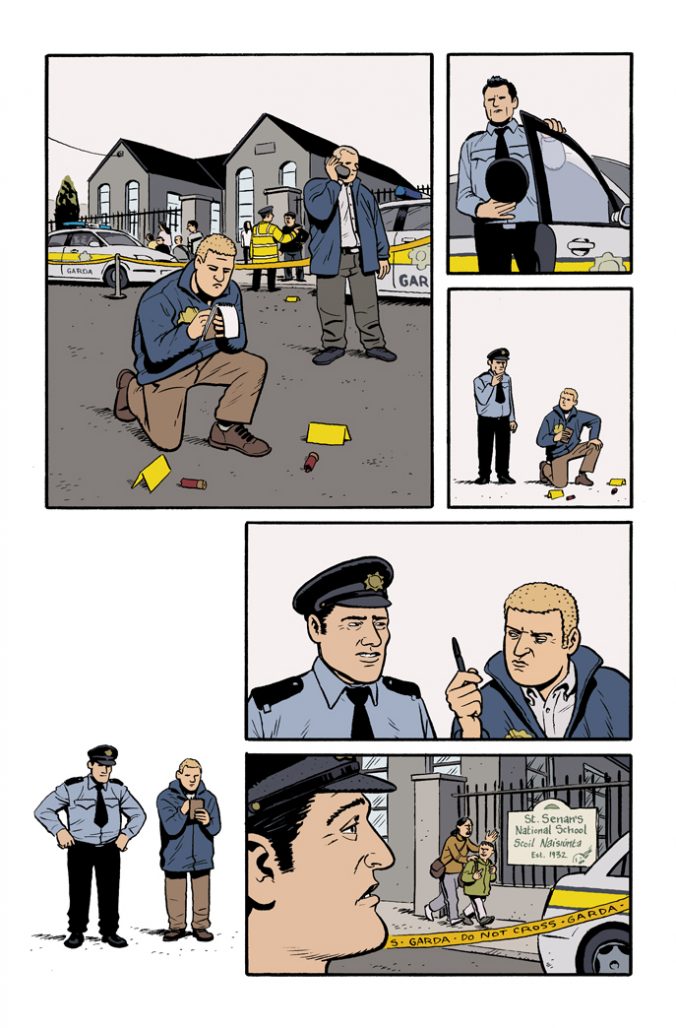
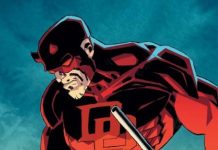
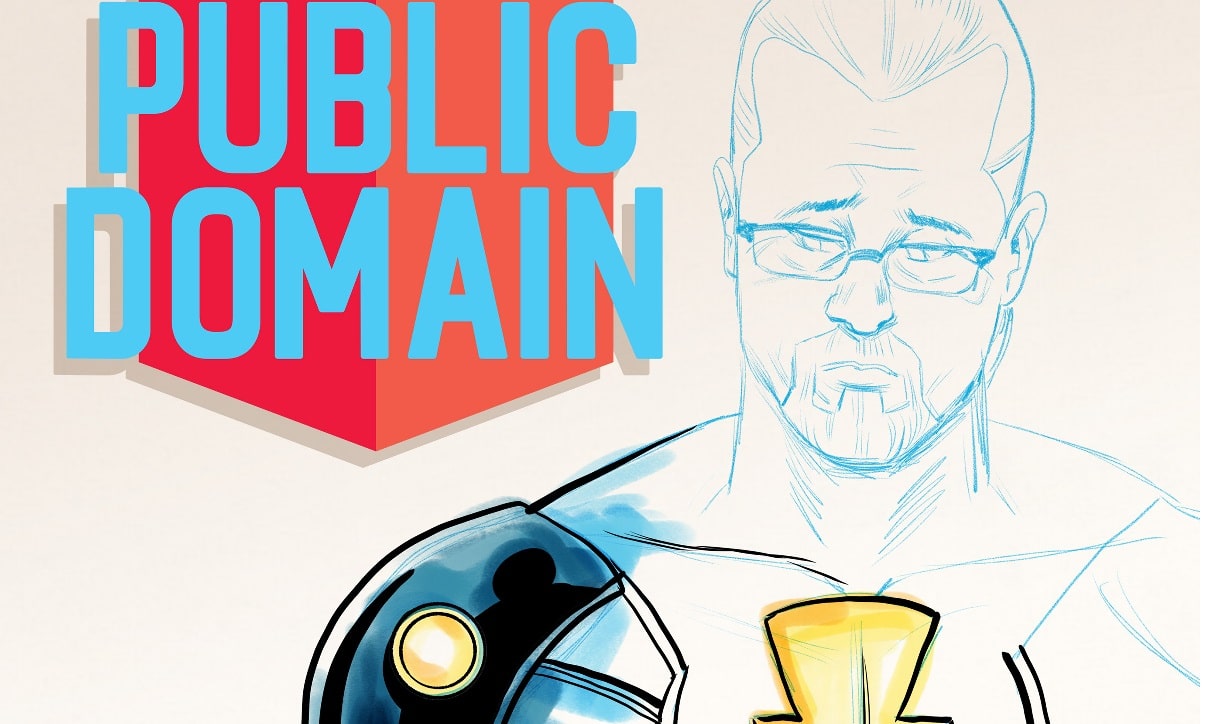
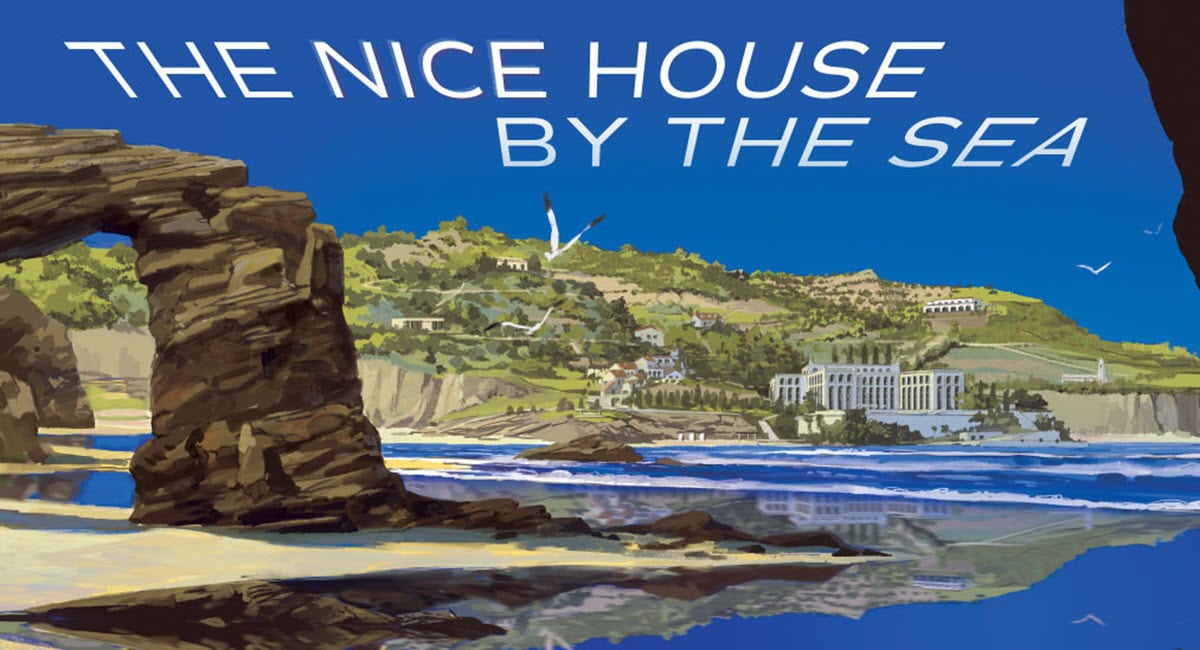



Isn’t this the series where Shalvey tells everyone they don’t know how to read comics and the only good comic reviews are the ones that are gloried PR pieces?
Comments are closed.